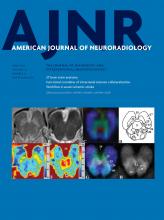Table of Contents
Perspectives
Patient Safety
- How to Reduce Head CT Orders in Children with Hydrocephalus Using the Lean Six Sigma Methodology: Experience at a Major Quaternary Care Academic Children's Center
The authors describe a Lean Six Sigma project with the goal of reducing the relative use of pediatric head CTs in their population of patients with hydrocephalus by 50% within 6 months. The existing baseline imaging practice for hydrocephalus was outlined in a Kaizen session, and potential interventions were discussed. An improved radiation-free workflow with ultrafast MR imaging was created. Baseline data were collected for 3 months by using the departmental radiology information system and data collection continued postintervention and during the control phase. The improved workflow resulted in a 75% relative reduction in the percentage of hydrocephalus imaging performed by CT between the pre- and postintervention/control phases. The authors conclude that the lean interventions in the pediatric hydrocephalus care pathway resulted in a significant reduction in head CT orders.
Practice Perspectives
Functional Vignette
General Contents
- Clinical Feasibility of Synthetic MRI in Multiple Sclerosis: A Diagnostic and Volumetric Validation Study
SyMRI is a quantitative synthetic MR imaging method where a single saturation recovery TSE sequence is used to estimate the proton density, longitudinal relaxation rate, and transverse relaxation rate and allows for a free range of synthetic weightings. Twenty patients with MS and 20 healthy controls were enrolled and synthetic MR imaging was implemented on a Siemens 3T scanner. Diagnostic accuracy, lesion detection, and artifacts were assessed by blinded neuroradiologic evaluation, and CNR by manual tracing. Synthetic PD-, T1-, and T2-weighted images were of sufficient or good quality and were acquired in 7% less time than with conventional MRI. Synthetic FLAIR images suffered from artifacts. Also, synthetic MRI provided segmentations with the shortest processing time (16 seconds) and the lowest repeatability error for brain volume. Synthetic MRI can be an alternative to conventional MRI for generating diagnostic PD-, T1-, and T2-weighted images in patients with MS with fast and robust volumetric measurements.
- New Clinically Feasible 3T MRI Protocol to Discriminate Internal Brain Stem Anatomy
Track density imaging (TDI) is a novel MR imaging postprocessing technique based on high angular-resolution diffusion acquisitions that generate super-resolution images derived by whole-brain probabilistic streamline tractography. TDI and echo modulation curve T2 mapping were combined with simultaneous multisection acquisition to reveal anatomic detail at 7 canonical levels of the brain stem. Compared with conventional MR imaging contrasts, many individual brain stem tracts and nuclear groups were directly visualized for the first time at 3T.
Commentary
- Clinical Impact of Ventilation Duration in Patients with Stroke Undergoing Interventional Treatment under General Anesthesia: The Shorter the Better?
The authors investigated the impact of early extubation and ventilation duration in a cohort of 103 patients that underwent thrombectomy under general anesthesia. Prolonged ventilation was associated with pneumonia during hospitalization and unfavorable functional outcome (mRS greater than or equal to 3) and death at follow-up. According to ROC analysis, a cutoff after 24 hours predicted unfavorable functional outcome with a sensitivity and specificity of 60% and 78%, respectively. The authors conclude that short ventilation times are associated with a lower pneumonia rate and more favorable clinical outcome.
- Interrogating the Functional Correlates of Collateralization in Patients with Intracranial Stenosis Using Multimodal Hemodynamic Imaging
The authors assessed correlations among baseline perfusion and arterial transit time artifacts, cerebrovascular reactivity, and the presence of collateral vessels on digital subtraction angiography. Arterial spin-labeling MRI and DSA were compared with BOLD MR imaging measures of hypercapnic cerebrovascular reactivity in 18 patients with symptomatic intracranial stenosis. In regions with normal-to-high signal on ASL, collateral vessel presence on DSA strongly correlated with declines in cerebrovascular reactivity (as measured on BOLD MRI). These data support the use of ASL MR imaging rather than invasive DSA to assess the presence of collateralization, even for patients with internal carotid stenosis from nonatherosclerotic etiologies. Also, collaterals identified on ASL with arterial transit artifacts correlated with decreased CVR compared with regions not perfused via collaterals.
- Differentiation of Speech Delay and Global Developmental Delay in Children Using DTI Tractography-Based Connectome
This study investigated whether diffusion tensor imaging tractography-based connectome can differentiate global developmental delay from speech delay in young children. Twelve children with pure speech delay, 14 children with global developmental delay, and 10 children with typical development underwent 3T DTI. Whole-brain connectome analysis was performed by using 116 cortical ROIs. Network metrics were measured at individual regions: strength, efficiency, cluster coefficient, and betweeness. Compared with typical development, global and local efficiency were significantly reduced in both global developmental delay and speech delay. Nodal strength of the cognitive network was reduced in global developmental delay, whereas the nodal strength of the language network was reduced in speech delay. This finding resulted in a high accuracy of >83% to discriminate global developmental delay from speech delay.








